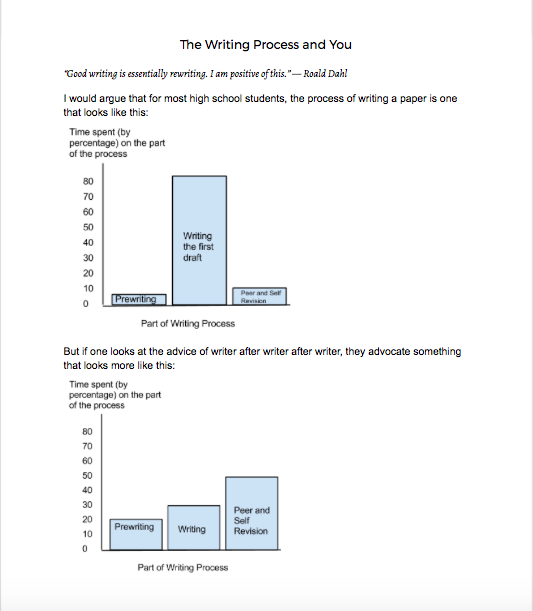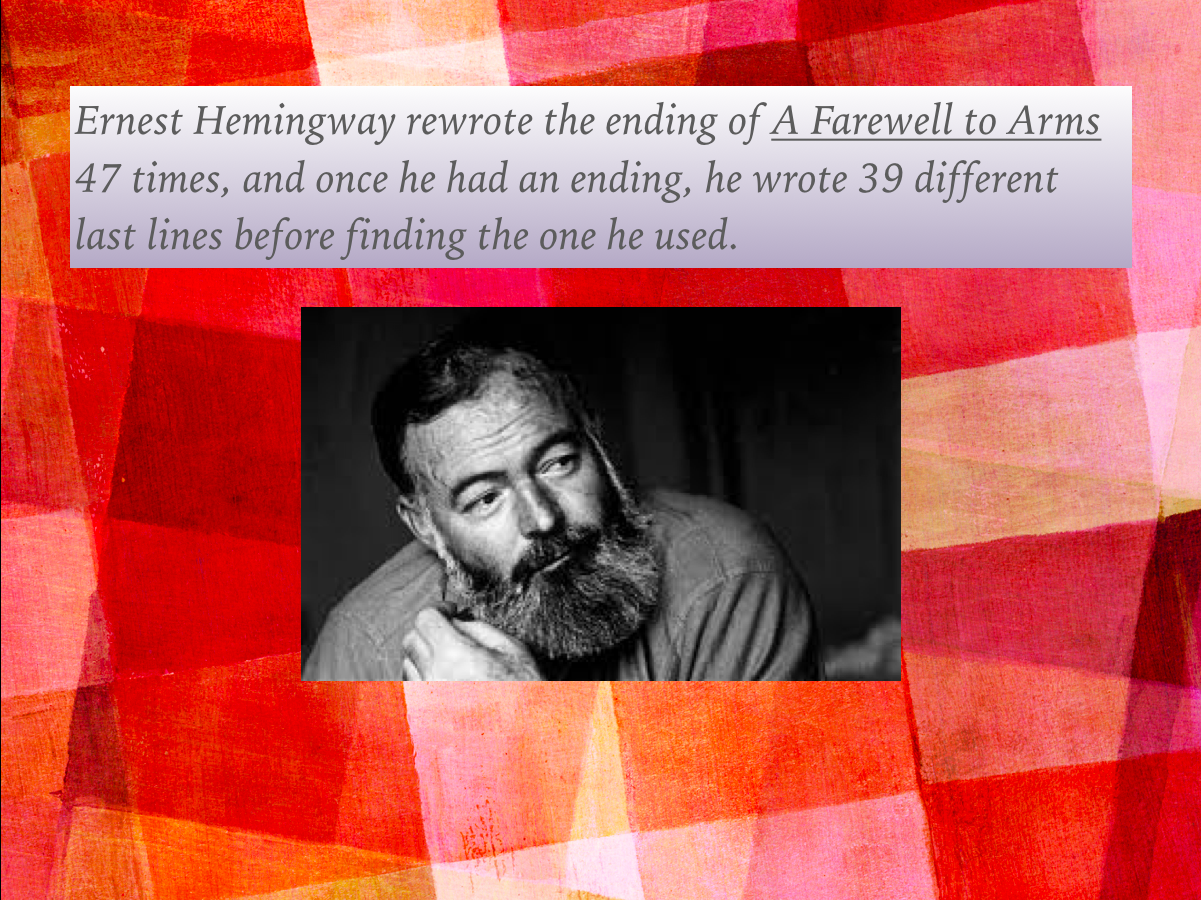“Published authors know that revision is the heart of producing effective writing…Developing writers don’t know this. They think of revising as a chore assigned because they aren’t good writers and can’t get their writing right the first time.” –Kathleen Dudden Rowlands in “Slay the Monster! Replacing Form-First Pedagogy with Effective Writing Instruction”
The most recent The Nation’s Report Card from the federal government is often quoted for its heart-breaking finding that barely a quarter of students in this country are able to write at a proficient level. But another striking fact buried within it, almost as an afterthought, is that one of the most regular indicators of a student’s success in writing is the number of times the student hits the backspace key, with over two-thirds of the students who scored in the top quartile having hit the backspace key at least 500 times over the course of composing their essays.
Donald Murray once said that “Writing is Revising”, and I think few, if any, experienced writers would disagree with him. In my own writing, I have regularly found that a robust series of revisions to be the gatekeeper standing between dull, disorganized writing and something more interesting and clear. I have also noticed the same to be true with my students’ writing, but for a long time I struggled to get even my most committed students to see it that way. They instead tended to see revision much as Kathleen Dudden Rowlands describes above, as something that is only needed if they “mess up,” and when I asked them to revise, they almost universally responded to me in one of two ways:
- They resisted and said something along the lines of “I don’t feel I need to revise/I just do one draft/I can’t find any changes to make.”
- Or they went back and quickly proofread their draft for commas, apostrophes, and other minor mechanical errors, and then handed it back as “revised.”
For years it seemed that no matter what I did–whether I begged, attached points, quoted famous authors extolling the importance of revision, or refused to grade until it was properly revised–nothing worked to get my students to truly engage in a real writing process.
The turning point for revision in my classroom came when I realized that I had to stop begging and bribing the students and instead teach them what a true writing process looks like and why it matters.
Since that point, I’ve made teaching the writing process a central element of my early writing instruction, and while it takes some time, the pay off worth is well worth it. By late October each year, nearly all of my students go through a real and robust revision process and see revision as an essential part of writing, and the way that affects the quality of their writing, the speed of their learning, and their ability to metacognitively look at their own work is amazing. With that in mind, here are my keys for how to teach students that writing is actually revising.
Start the Conversation
Most students enter my class with a one-draft-and-done-mindset, and unless I can show them the value of going through a real writing process, they will likely continue to do it poorly and/or find every way possible to get out of doing it. To make the value clear, I start by comparing how most students commonly resist revision to the effusive praise of revision often given by professional writers (see sheet below). We then have an open-ended discussion about why this enthusiasm gap concerning revision exists and its implications.

The result of this conversation tends to be near consensus amongst the class that revision probably does lead to higher quality work, but doing that much revision is a lot of extra work, which is why so many students often resist it. This conclusion might not seem like much of a victory, as its not exactly a glowing endorsement, but the small act of acknowledging that revision leads to better writing is an important first step towards understanding why the writing process is essential.
Show Them the Value
I next make the case to my students that while on the surface going through rounds of revision seems like more work, if done right, it can actually lead to a better product in the same (or even less) time because of a function of our brains called working memory. The basic definition of working memory is that it is our attention, or more accurately the number of things we can pay attention to at once. The main problem with working memory is its size, which psychology professor Peter Doolittle describes in the TED talk below as being “the size of a pea.”
According to him, the limit to the number of things we can pay attention at once is four, which pales into comparison to the hundreds of potential things we could pay attention to in any given moment. How this factors into writing is that when writing anything, one needs to focus on far more than four things. To make this point, I usually follow my instruction on working memory with a class activity where we generate a list of everything a writer needs to be aware of when writing an essay on a book. Here is the list from the last time I did this:
- the plot of the book
- the student’s interpretation of the book
- what the teacher will be looking for in the essay
- the format
- sentence level organization
- overall organization
- word choice
- sentence structure
- grammar
- clarity
- use of rhetorical devices
- transitions
We then think about what a paper would look like if the writer only did a good job on four of those things at any given moment, which is what generally happens when writers only do one draft. No matter how you divide it up, it generally isn’t pretty, which is the point. To paraphrase Ernest Hemingway, even for the best writers, early drafts are little more than human waste.
Of course, I do admit to students that writers will often try to get around the limits of working memory by constantly toggling their focus between the different elements, but what they likely don’t realize is doing that actually slows down and clouds thinking, as whenever we switch our focus, we need to reorient, and the cumulative result of doing that hundreds or thousands of times is generally disjointed writing that takes longer to produce.
The lesson then concludes with me doubling back to the beginning and saying that the reason professional writers advocate a robust revision process is because it produces higher quality work while allowing them to be more efficient with their time too, or put more simply, you can do better work in less time.
Structure the Class So That Going Through a Writing Process Is Easier
The instruction above is a bit of an oversimplification of how working memory affects writing and the advantages of revision, but I find it plants a seed concerning the importance of revision. At this point, students often aren’t completely sold on engaging in a robust writing process, but they generally are more open to it. The next step, and the true key to convincing students of the value of a writing process is to get them to engage in it and see the results for themselves. To do this right, I model the process and provide significant structure early on. Here is a prewriting assignment I do with the research paper that does both:
Harlem Renaissance Research Outline
When I first handed out this assignment, I worried that students would be turned off by its structure in the way that they are so often turned off by the highly-structured five paragraph essay or sonnet, but the opposite was true. Nearly all of them were delighted to have a clear model and structure that still granted them the autonomy to take the writing wherever they wanted. I’ve found that this mix of concrete answers and choice is key to helping students understand and undergo a writing process while still giving them the freedom to do a process and produce a product that is unique to them.
Make Revision a Focus Area
Students tend to learn best whatever the teacher focuses on the most. The foolproof way to make sure your students learn about metaphors is to focus on them a lot. Unfortunately, we teachers can only focus on so much, so we need to be thoughtful about our focus areas. This careful picking of focus areas is the idea at the core of Reading Apprenticeship’s Metacognitive Framework or Dave Stuart Jr.’s These Five Things Framework, each of which argues increased focus on a handful of core goals. I would argue that due to its ability to promote growth, it is worth making revision a focus area in your class. Here are some of the ways that I do that:
- I regularly pull quotes of good writers talking about revision before we do a round of revision. Here is a wonderful collection of revision quotes from The Atlantic and here is an example of one of my slides that does this:

- I give them serious time to revise. Linda Christensen, author of multiple books on writing instruction and director of the Oregon Writing Project, has students do 3-4 days of in-class drafting on a piece before turning it in. I strive to do the same, as it is a way to ensure all of my students go through a thorough writing process.
- We regularly tackle classroom content using revision. For example, if we learn about using colons and semicolons, our practice will be students finding ways to insert them into the paper they are working on right now, as opposed to a doing disconnected worksheets.
- I give my feedback to student papers on earlier formative drafts, not summative final drafts. A whole post on this approach and its many advantages is coming soon, but one advantage is that doing this helps me to better encourage and guide students through the writing process.
Matt

Leave a comment